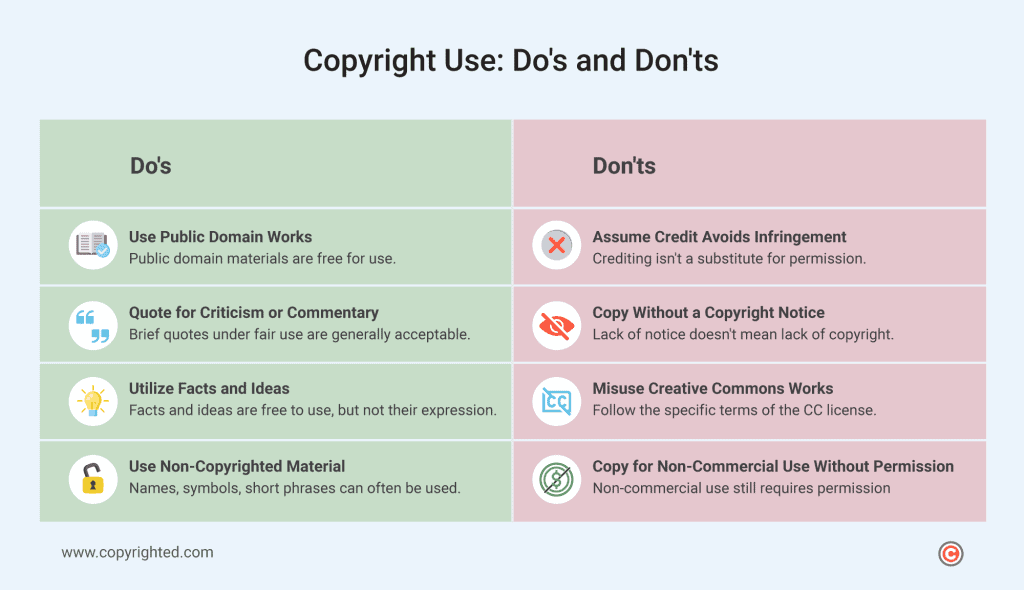Whether you’re a blogger who constantly needs images for your blog, or a content creator using background music for your videos, you can’t deny the fact that technology has made it extremely easy to copy, modify, and share content of various formats across different platforms.
At the click of a button, a modified version of copyrighted material can get thousands, even millions of views.
However, the majority of content publishers lack an understanding of copyright and fair use laws. This also puts them in a spot where they might make unintentional mistakes but also opens up the possibility of facing legal troubles that are both against the law and can be a real financial burden.
In this article, we’ll shed light on whether you can modify copyrighted content, the potential consequences, and the do’s and don’ts to protect yourself from copyright infringement.
Let’s dive into the details.
- You can modify copyrighted material, but it’s important to stay within the legal boundaries set by the Copyright Act to avoid infringement.
- Changing copyrighted material without understanding copyright laws can lead to severe consequences.
- Reckless modifications risk a loss of trust and credibility from your audience.
Table of Contents
Can You Change Copyrighted Material?
Yes, you can change and modify copyrighted work, but only within certain limits and under specific circumstances.
Let’s unpack this a bit further.
The Copyright Act grants you the right to use, distribute, display, and create derivative works from materials protected by copyright, subject to specific conditions.
In simple terms, you can modify copyrighted work to an extent, as long as you play by the rules.
But how much change to avoid copyright infringement is enough? That’s the tricky part.
There’s no fixed percentage or formula, minor tweaks may still violate copyright, while significant transformation could qualify as fair use or even be considered a derivative work. The extent and purpose of the change matter just as much as the nature of the original content.
While creativity is encouraged, there are specific do’s and don’ts to avoid copyright infringement and legal consequences.
As a creator or online business, it’s essential to be aware of these do’s and don’ts that accompany this creative privilege, so you can steer clear of copyright infringement and its associated legal consequences.
What Happens When You Change Copyrighted Material?
Now that you’re aware of the possibility of altering copyrighted material, it’s time to understand the potential consequences of changing copyrighted material without proper understanding and adherence to copyright laws.
Bear in mind that the individual holding the copyright maintains substantial control over their original works. As a result, altering or modifying copyrighted material may result in certain outcomes, depending on the nature and extent of the changes made.
From the possibility of copyright infringement claims to the importance of obtaining permission, understanding these aspects is essential for anyone navigating the world of copyrighted content. So, let’s navigate through the details of copyright law and the implications of modifying original works.
Copyright Infringement Claims
One of the most significant risks associated with modifying copyrighted material is copyright infringement claims. When the changes made to the original work are significant and extend beyond the acceptable limits of fair use, you may be exposed to legal action.
The fair use doctrine, an important concept in copyright law, allows for the limited use of copyrighted material without permission from the copyright owner for purposes such as criticism, commentary, news reporting, teaching, scholarship, and research.
However, it’s important to note that fair use is not a one-size-fits-all defense to copyright infringement. Exceeding the boundaries of fair use may result in not only legal consequences but also financial penalties and damage to your reputation.
This raises the question of copyright infringement vs inspiration, a subtle but critical distinction. Drawing inspiration from someone else’s work is legally and creatively acceptable, but crossing the line into duplication, even with changes, could lead to infringement. The more your work resembles the original, the higher the risk of crossing that line.
Permission Requirement
While the fair use doctrine provides a potential defense, it’s important to note that in many instances, unauthorized use and modification of copyrighted material will require you to get the permission of the copyright owner.
This is especially true when contemplating substantial changes that could significantly impact the integrity of the original work. In such instances, reaching out to the copyright holder is generally advisable.
Securing permission not only ensures legal compliance but also builds positive relationships with creators, contributing to a collaborative and respectful creative community.
Derivative Work Considerations
Creating derivative works based on copyrighted material involves making changes or additions that result in a new creative expression that is unique from the original.
If your modifications reach this level, your creation may fall as a derivative work. It’s important to understand that derivative works are subject to their copyright protection and may require separate authorization from the copyright holder.
This consideration emphasizes the importance of approaching copyrighted materials with respect and ensuring adherence to copyright laws while encouraging innovation and creativity.
Loss of Credibility
Careless modifications to copyrighted content not only jeopardize the quality and integrity of the original work but also undermine your brand’s credibility.
Audiences are discerning, and they may associate your content with unauthorized changes to someone else’s creation, resulting in a loss of trust and credibility.
While creativity is valued, striking a balance is essential. It’s also important to show respect for the original work and improve it through transformative changes, avoiding any negative implications for your brand.
Cease and Desist Orders
Copyright owners have the legal right to issue cease and desist orders, instructing you to stop using and modifying their copyrighted material.
Ignoring these orders can complicate matters and may escalate to legal action. This is where a clear understanding of fair use becomes important.
If your modifications align with the principles of fair use, you may have a legal defense. However, it’s significant to assess each situation carefully and be prepared to justify your decisions, as fair use is a nuanced concept that demands meticulous consideration.
The Do’s and Don’ts You Must Know

Now that we’ve explored the potential pitfalls, let’s outline some do’s and don’ts to help you with the process of modifying copyrighted material without falling into legal trouble.
Do’s
- Utilize material in the public domain: You are permitted to employ any work existing in the public domain, including federal government documents, materials generated before 1923, and materials produced before 1977 lacking a copyright notice.
- Always quote intriguing or interesting content: The Copyright Act acknowledges that brief quotations for criticism, commentary, or news reporting are considered fair use. It’s essential to ensure that the quote constitutes only a small portion of the work and does not replicate the core essence of the material.
- Employ facts and ideas: Copyright Law protects the expression of facts and ideas, focusing on the form, combination, and structure of documents rather than the facts themselves. Facts and ideas from articles or websites are free to be utilized.
- Use materials not subject to copyright: Beyond facts and ideas, several material categories are not protected by Copyright Law, such as names, familiar symbols, ingredient listings, short phrases, titles, slogans, and procedures (note that some may be protected by trademark).
Don’ts
- Don’t assume giving credit will avoid copyright infringement: Crediting the author doesn’t grant automatic permission to use copyrighted material. Explicit permission or fair use rights are necessary.
- Refrain from copying just because a copyright message is not shown: Copyright protection is granted automatically to published works following the 1978 law change, regardless of the presence of a copyright notice.
- Do not equate Creative Commons with “free for grab”: Creative Commons licenses serve as guidelines for sharing creative work, allowing creators to specify the terms under which others can use, share, and modify their content. These licenses come in various types, each with distinct rules governing usage, such as commercial permissions and modification allowances. They facilitate collaborative efforts and ensure a fair and transparent framework for sharing creative content.
- Avoid copying without permission, even for non-commercial use: Commercial use isn’t the sole criterion for copyright infringement. Permission from the author is necessary, regardless of commercial intent.
- Do not assume removal of material resolves copyright issues: Simply removing copyrighted material doesn’t absolve copyright infringement. Legal consequences may persist even after removal, should the author pursue legal action.
- Do not copy due to difficulty identifying the copyright holder: The inability to identify a copyright holder does not grant free rein to copy material. Attempts to obtain permission, even if unanswered, are essential to comply with copyright law. If you’re aware of the copyright owner, you can reach out to them directly. If you’re unsure about ownership or have other questions, you can ask the Copyright Office to check its records or do the search yourself.
Frequently Asked Questions
Can I modify any copyrighted material without consequences?
No, you can modify copyrighted material, but it must be within legal limits outlined by the Copyright Act to avoid infringement consequences.
What are the risks if I don’t understand copyright laws?
Lack of understanding can lead to unintentional mistakes and potential legal consequences, including copyright infringement claims and financial penalties.
What is the Fair Use Doctrine, and how does it apply to me?
Fair use allows limited use of copyrighted material for specific purposes; however, it’s not a blanket defense and requires careful consideration of each situation.
Do I need permission to use copyrighted material for non-commercial purposes?
Yes, permission is necessary regardless of commercial intent; even non-commercial use without permission can lead to copyright infringement.
Does removing copyrighted material resolve copyright issues?
Simply removing material doesn’t absolve infringement; legal consequences may persist, requiring thoughtful consideration even after removal.
What should I do if I can’t identify the copyright holder?
Inability to identify the copyright holder doesn’t grant permission; attempts to obtain permission, even if unanswered, are essential to comply with copyright law.


